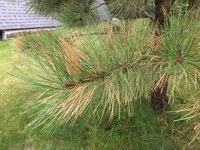Dakota Gardener: Trees in the Spring - What to Expect
(Click an image below to view a high-resolution image that can be downloaded)
By Joe Zeleznik, Forester
NDSU Extension
North Dakota is a big state.
In some places, trees are just beginning to bud out, while in other locations, they’re already done flowering and leaves have nearly fully expanded. Winter has barely left the northeast while spring arrived in the southwest awhile ago.
What can we expect to see in our trees this spring?
A lot can happen to trees during the winter. Conifers often suffer from “winter injury,” a general term that encompasses symptoms from a number of causes. Sometimes, winter temperatures were simply too cold, or perhaps we had a warm, sunny, windy day that dried out conifer needles, or maybe we had a three-day warm spell that was followed by temperatures quickly plummeting back to negative numbers.
Any one of these scenarios can cause branches, needles or parts of needles to die. You can do very little about this damage after the fact. Fortunately, the damage is usually minimal and the trees will recover on their own.
Trees can lose up to a fourth of their leaves (or needles) without suffering any stress at all. That’s an incredible biological feature of trees that just blows me away whenever I think about it.
Another thing that emerges as the snow melts away are signs of damage from rabbits, voles and deer that were trying to survive the cold. Branches or entire stems can be girdled when these hungry critters peel the bark back to get at the sugar-rich tissue underneath.
This often spells doom for the tree. The leaves might flush out in the spring, but growth is short-lived as the root systems quickly starve because they can get no food from the leaves. As a last resort, the tree might send up new sprouts from the base, trying to survive. These sprouts might be trained into new stems, but the tree will have to start almost from scratch.
Unfortunately, you can do very little about this type of damage as well. Pruning paints and wound sealants do not help the trees recover more quickly, nor do they keep out insects or diseases. Even if a tree is only partially girdled, your best option is to sit back and wait, and let the tree recover on its own.
Once warmer temperatures arrive - and stay - we’re expecting a third year of an outbreak of cankerworms. Caterpillars of spring cankerworm (Paleacrita vernata) and fall cankerworm (Alsophila pometaria) defoliated trees throughout North Dakota during 2018 and 2019.
Many common insecticides can be effective against cankerworms, but timing is critical. These chemicals are useful when the caterpillars are still young; unfortunately, we usually don’t notice the damage until it’s too late.
However, we can use growing degree days (GDD) to predict roughly when these pests will begin their feeding. Using a base temperature of 50 F, the same as that used to predict corn growth, cankerworms will begin feeding at about 148 GDD and can be controlled with insecticides from then until about 290 GDD.
The dates when we reach those GDD vary widely across the state, so check out the North Dakota Agricultural Weather Network (NDAWN, https://ndawn.ndsu.nodak.edu) and utilize its Corn GDD app to track degree days in your locality. In fact, cankerworms likely already are feeding on trees in the southwest, so get out and scout for them if you live in this area.
Have a great spring!
NDSU Agriculture Communication - May 5, 2020
| Source: | Joe Zeleznik, 701-231-8143, joseph.zeleznik@ndsu.edu |
|---|---|
| Editor: | Ellen Crawford, 701-231-5391, ellen.crawford@ndsu.edu |




